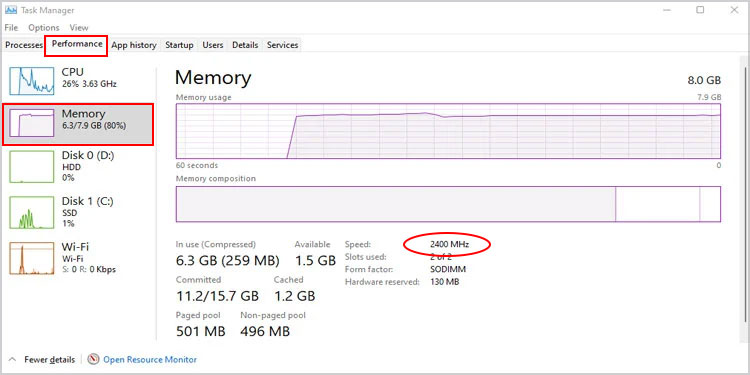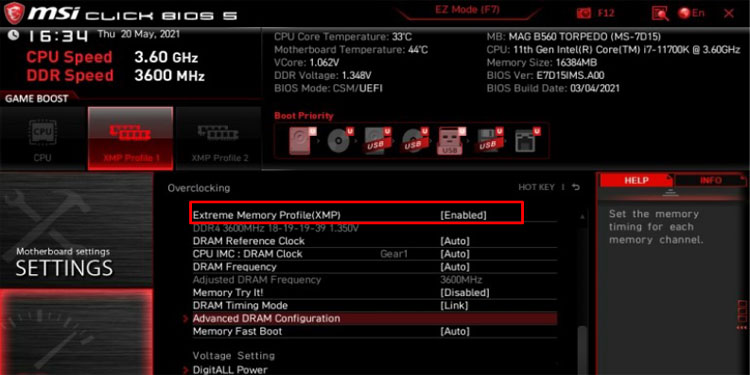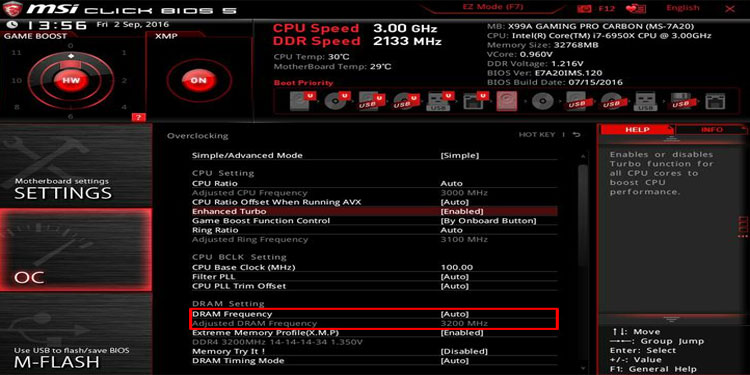How To Fix My Ram Speed
Are you a PC enthusiast looking for means to make your arrangement more efficient? If yes, y'all might want to commencement with changing the RAM speed. Adjusting the RAM speed drastically changes your figurer'southward performance.
Whether you want to increase or limit your RAM speed, nosotros will provide you with the necessary steps to practise so.
So, without further ado, let us see how nosotros can change RAM speed in BIOS.
How to Bank check My Current RAM Speed
When you buy a RAM stick, a manufacturing company advertises a certain speed (usually in MHz) at which the RAM transfers its data to and from the CPU. However, the BIOS sometimes limits RAM speed, and your computer cannot fully perform like it is supposed to.
To cheque your current RAM speed, delight follow these steps:
- Press Ctrl + Alt + Del key simultaneously and select Task Director.
- Click on More details if the Task managing director but has a listing of running processes.
- Now, go to the Functioning tab, then click on Memory.

- Hither, you tin can encounter all the details about your physical retention, including its speed, slots, in-use, and available retention.
If the speed shown here does not friction match the speed that the manufacturing visitor advertises, you lot might want to accommodate some settings in the BIOS to conform RAM speed.
Note: You tin only adjust the RAM speed from the BIOS. However, there are third-political party applications, like CPU-Z, to become the details about your physical memory.
Before We First
Earlier changing the RAM speed, y'all should know that changing the wrong BIOS settings may crusade your organisation to crash randomly. Furthermore, tweaking RAM settings to the extreme can brand your organisation malfunction.
So, if you lot face whatsoever issues afterwards yous salve these settings, information technology is recommended to revert these changes. However, if you cannot revert the changes, delight reset the BIOS to default settings.
You cannot suit your RAM speed in normal laptops. The frequency on these laptops is set to maximum past default. Fortunately, the manufacturer offers Extreme Memory Profiles for gaming laptops, which lets you use more RAM speed than the advertised amount.
How to Change RAM Speed in BIOS
Depending on your motherboard, your BIOS volition take settings with dissimilar names. So, yous will need to navigate through the BIOS to search for the settings mentioned in the steps below.
Enable Memory Profiles
Enabling the memory profiles or overclocking profiles allows the user to select from a multifariousness of memory speeds. Each profile uses different memory speeds and consumes different voltages.
It as well increases RAM's speed more than than the advertised amount without dealing with the hassle of transmission overclocking.
AMD and Intel motherboards have different names for overclocking. For AMD motherboards, you can search for settings named DOCP (Direct Overclock Profile), whereas for Intel motherboards, it'due south XMP (Extreme Retentivity Profile).
First, y'all need to make certain that your motherboard supports XMP. If your motherboard does not support Farthermost Memory Profile, please follow the other mentioned process to change the RAM speed.
Now that you know your motherboard supports retentiveness profiles, you volition have to navigate to the BIOS to enable it. Here're the steps:
- To Enter the BIOS, printing the Delete key or F2, depending on the motherboard manufacturer, during the organization boot-up process.
- Once y'all enter the BIOS, you volition need to find the XMP contour or DIMM profile settings. These settings are generally located in the memory direction section of the BIOS.
- There will be two or iii XMP profiles depending on the XMP version. Enable XMP and select any one of the profiles to modify RAM speed.

Modify Memory Frequency Limiter
Some motherboard, by default, has a RAM frequency limiter. This means that the speed at which RAM and CPU transfers data is restricted, and the speed cannot go beyond this restriction point.
Enter your motherboard's BIOS and search for settings with a proper noun such as RAM frequency Limiter or Memory Frequency Limiter. Set this value to the maximum to employ all of your RAM potentials.
Your motherboard may or may non have these settings. If it's the latter, please follow another method to change RAM speed.
Change DRAM Speed
If you are turning on the PC for the start time, the motherboard will automatically fix a lower DRAM frequency than the advertised speed. Unless we change the RAM speed from the BIOS, you will non become the bang for your bucks.
Here're the steps to change the DRAM speed:
- Navigate your BIOS and search for DRAM setting.
- You will need to set your DRAM frequency to manual to adjust them. Past default, DRAM frequency will be Auto.

- One time you lot perform the necessary changes, salve the changes and exit the BIOS.
Related Questions
Which Is Better? More than RAM or Faster RAM?
More RAM means information technology can store more data from an application giving the CPU more information to procedure. Pregnant that it can run multiple applications in the groundwork.
In dissimilarity to college RAM, faster RAM means a college data transfer rate.
So, the reply really depends on what you use the PC for. If you run multiple applications simultaneously, information technology is recommended that y'all use more than RAM. However, if you want more than frames per second when gaming, information technology is only ideal that you apply RAM with more speed.
Is Overclocking Good?
If your are a PC expert and yous want to get the virtually out of your computer, it is always recommended to overclock your PC components. Even so, your organisation tin can crash if yous perform farthermost overclocking.
Why Do RAM Manufacturers Advertise Higher RAM Speed When the Industry Standard Stock Clock Speed Is Much Lower?
The advertised RAM speed is the maximum speed at which the RAM tin perform. Then, if a motherboard runs the RAM at the advertised speed, it tin crusade arrangement instability. Therefore, the BIOS automatically runs RAM at a lower speed.
If your reckoner's RAM runs at a slower speed than advertised, you can enable memory profiles that enable the motherboard to apply the advertised RAM speed.
For Intel, y'all can search for BIOS settings named XMP (Extreme Memory Profiles), whereas for AMD search for settings named DOCP (Directly OverClock Profile) or AMD Retentiveness Profiles in BIOS.
Furthermore, some CPUs volition take a RAM speed limit which information technology can handle. So if your CPU just supports up to a certain amount of overclocking, RAM speed will not get beyond that point.
Conclusion
Summing it up, if you are on a desktop PC, you can simply alter your RAM speed by navigating the BIOS. Still, it is not ever that unproblematic for virtually laptops.
Moreover, changing the RAM speed may not e'er be beneficial. Sometimes, it can even crusade your system to crash. In that case, revert these frequencies to previous settings.
How To Fix My Ram Speed,
Source: https://www.technewstoday.com/bios-ram-settings/#:~:text=You%20cannot%20adjust%20your%20RAM,speed%20than%20the%20advertised%20amount.
Posted by: blairgual1950.blogspot.com


0 Response to "How To Fix My Ram Speed"
Post a Comment